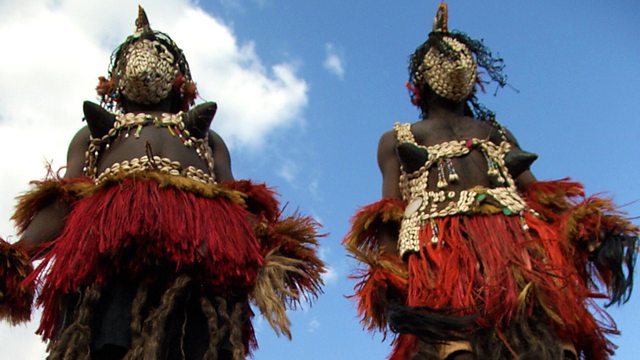Ms Koné, a tall 60-year-old with cropped greying hair, says the men have nothing to worry about.
Koné女士60歲,高個,灰白短發,她認為男性沒什么好擔心的。
Her marionettes do not have spirits or powers because they are “modern”, made of clay and papier-mâché rather than wood.
她做的木偶沒有靈魂或超能力,因為這些木偶是“現代的”,使用黏土和紙膠混合物制成,而非木頭制作。
She abjures the old-fashioned kind.
她正式宣布放棄過時的做法。
“I would never touch them,” she says.
“我永遠都不會用那種方法,”她說。
“The marionette itself couldn’t do anything, but the men around it could do very bad things.”
“木偶本身做不了什么,但木偶周圍的人卻可以做非常壞的事。”

She grew up in Koulikoro, about an hour from Bamako on the banks of the Niger river, a town known for its marionettes, masks and unique, sacred statuettes that represent the dead.
她在庫利科羅長大,從巴馬科到尼日爾河岸邊大約一個小時,這座城鎮以木偶、面具和代表死者的獨特神圣雕像而聞名。
She was born into a noble family in Mali’s complex caste system, rather than an artistic one, and her parents did not support her ambitions.
她出生在馬里復雜的種姓制度下的一個貴族家庭,并非藝術世家,她父母也并不支持她的雄心壯志。
“It was difficult for my family to accept,” she says.
“我的家人都很難接受,”她說。
Of 12 siblings, she is the only artist, and the only daughter who chose not to have children, believing they would hamper her career.
在12個兄弟姐妹中,她是唯一的藝術家,也是唯一一個選擇不生孩子的女兒,因為她認為孩子會妨礙她的事業。
Coming of age in the early decades of independence, she was a beneficiary of the investment in the arts made by Modibo Keïta, Mali’s first president (from 1960-68).
在馬里獨立后的最初幾十年里,她受益于第一任總統莫迪博·凱塔(1960-68在任)對藝術的投資。
His government “understood that the arts were a very important part of creating a national identity and bringing people together,” says Mary Jo Arnoldi, a curator at the National Museum of Natural History in Washington and an expert on marionette culture.
凱塔的政府“明白藝術是創造國家認同和把人民團結在一起的重要組成部分,”華盛頓國家自然歷史博物館館長、木偶文化專家瑪麗·喬·阿諾爾迪表示。
Ms Koné was educated at the National Institute of the Arts (INA), a cutting-edge college that, says Ms Arnoldi, “broke down gender and caste boundaries” and produced some of Mali’s finest artists.
Koné女士曾在國家藝術學院上學,阿諾爾迪說,“這是一所前沿大學,打破了性別和種姓歧視,”誕生了馬里最好的一批藝術家。
譯文由可可原創,僅供學習交流使用,未經許可請勿轉載。












